Charles E W Bean, Diaries, AWM38 3DRL 606/260/1 - 1916 - 1930 - Part 18
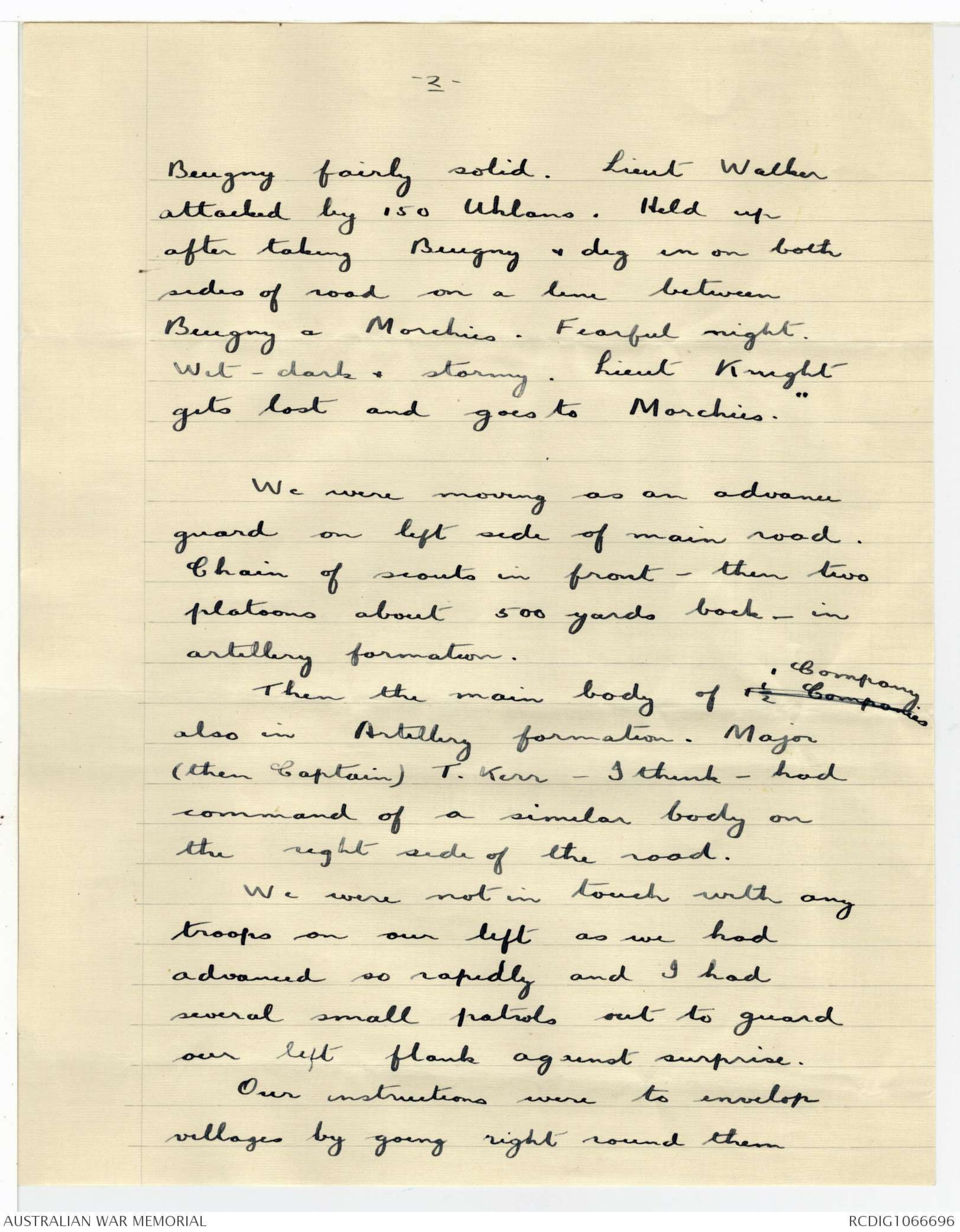
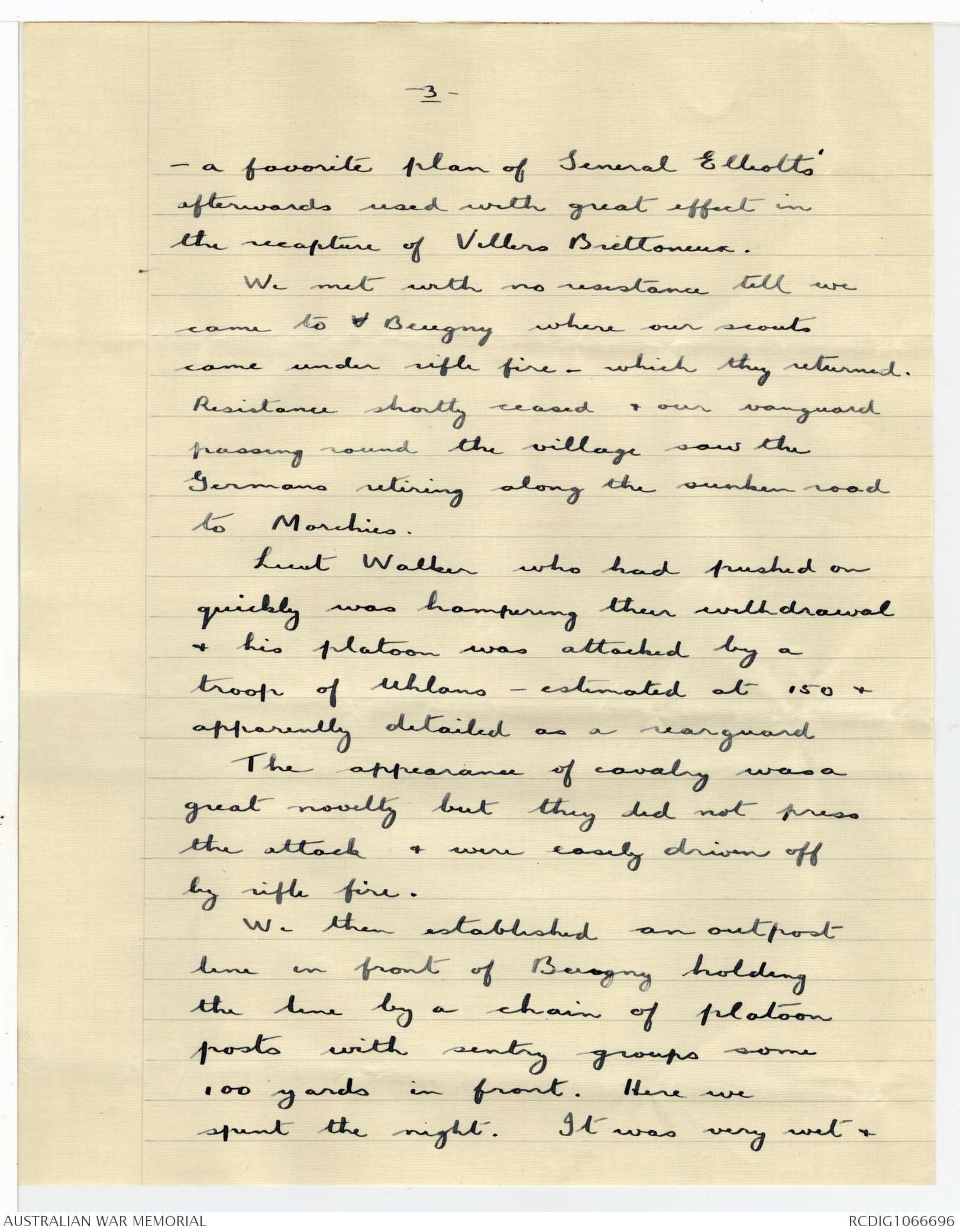
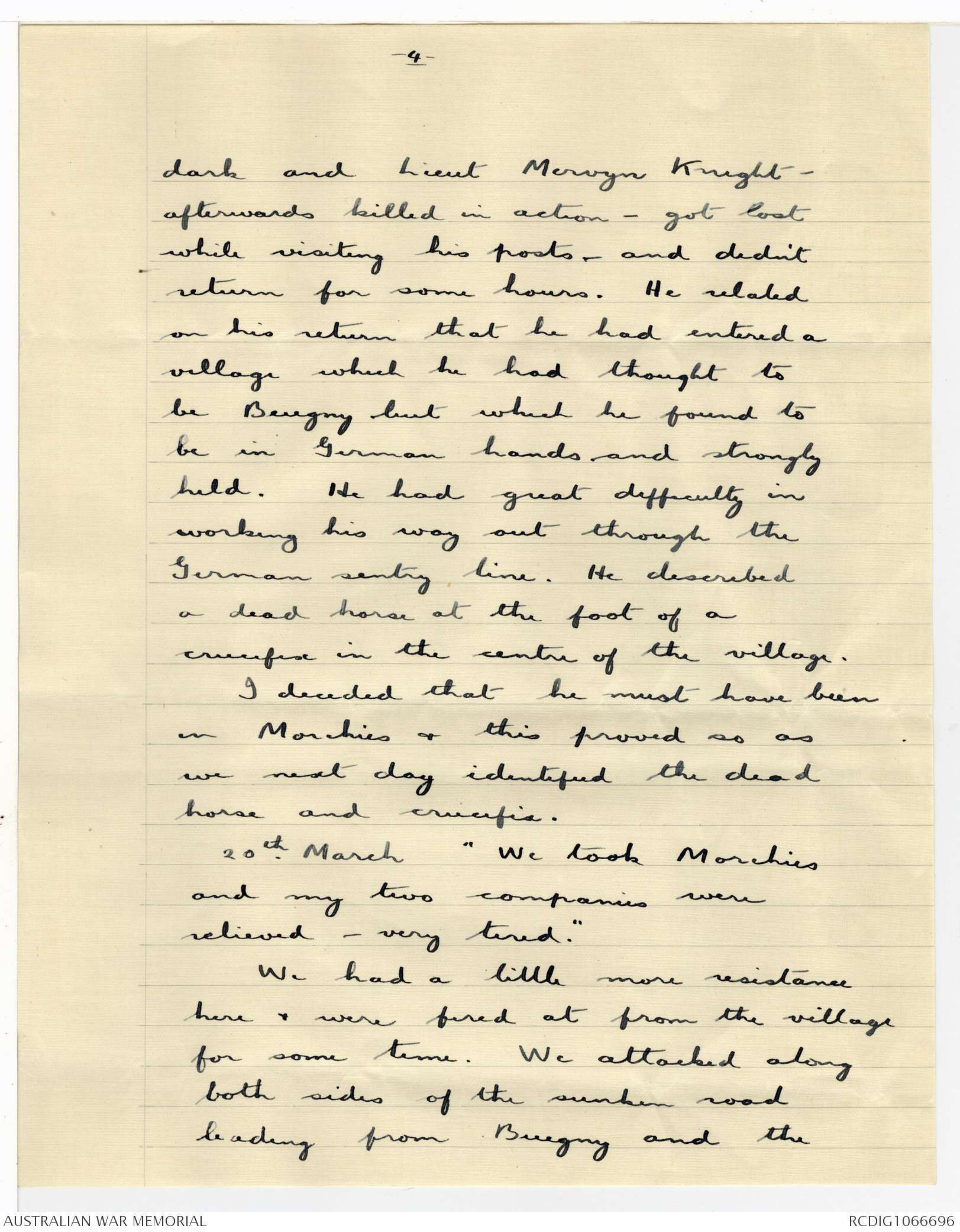
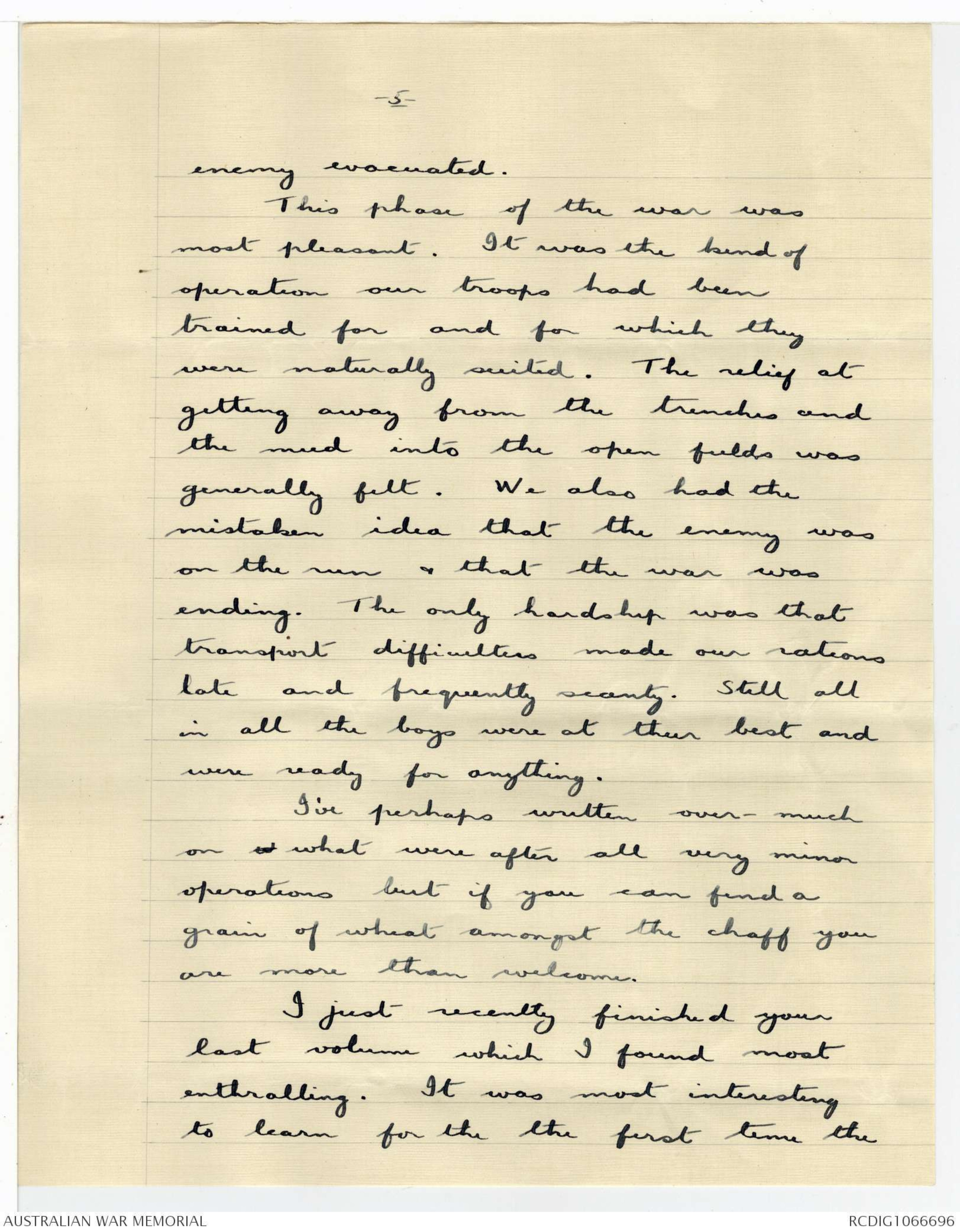
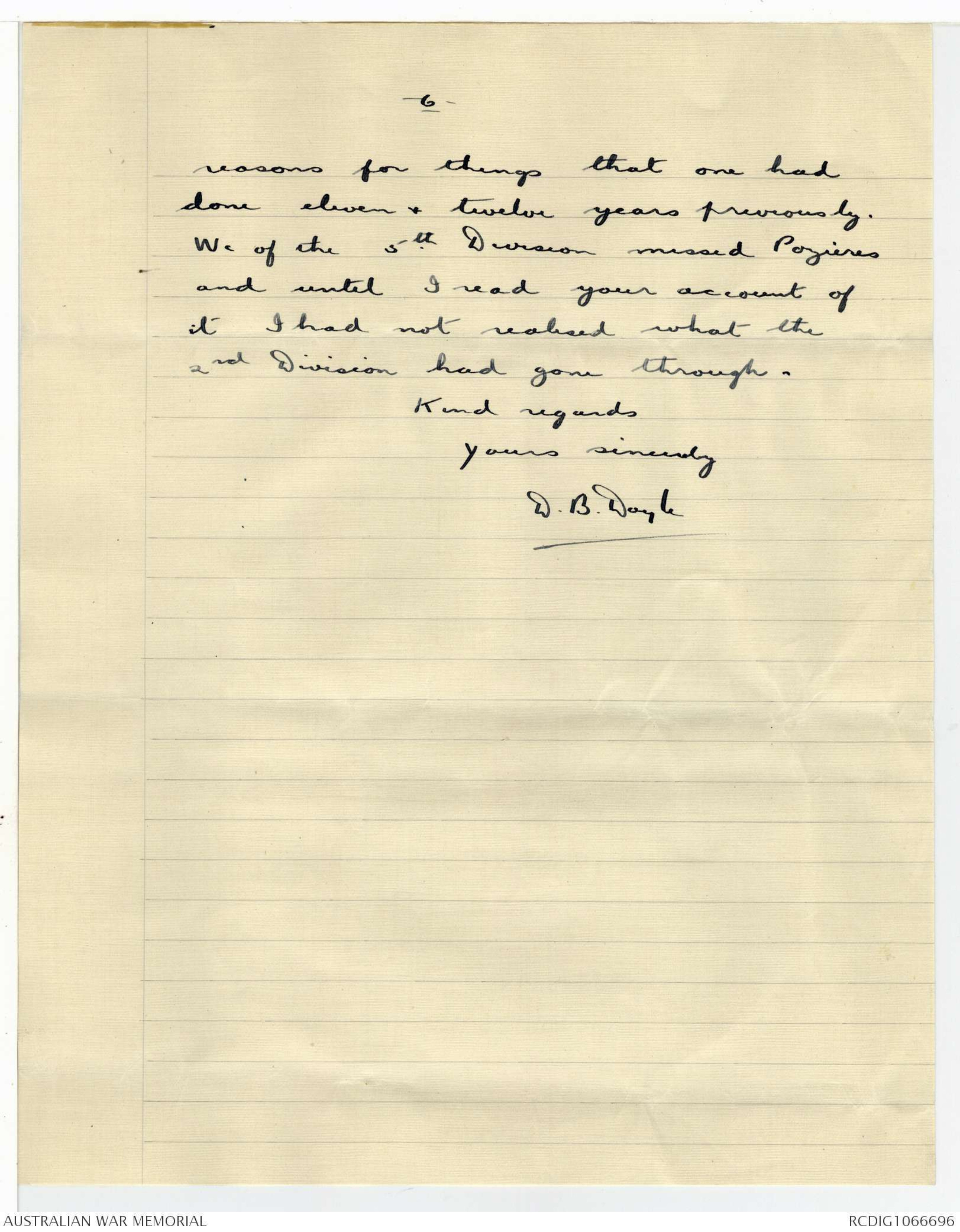
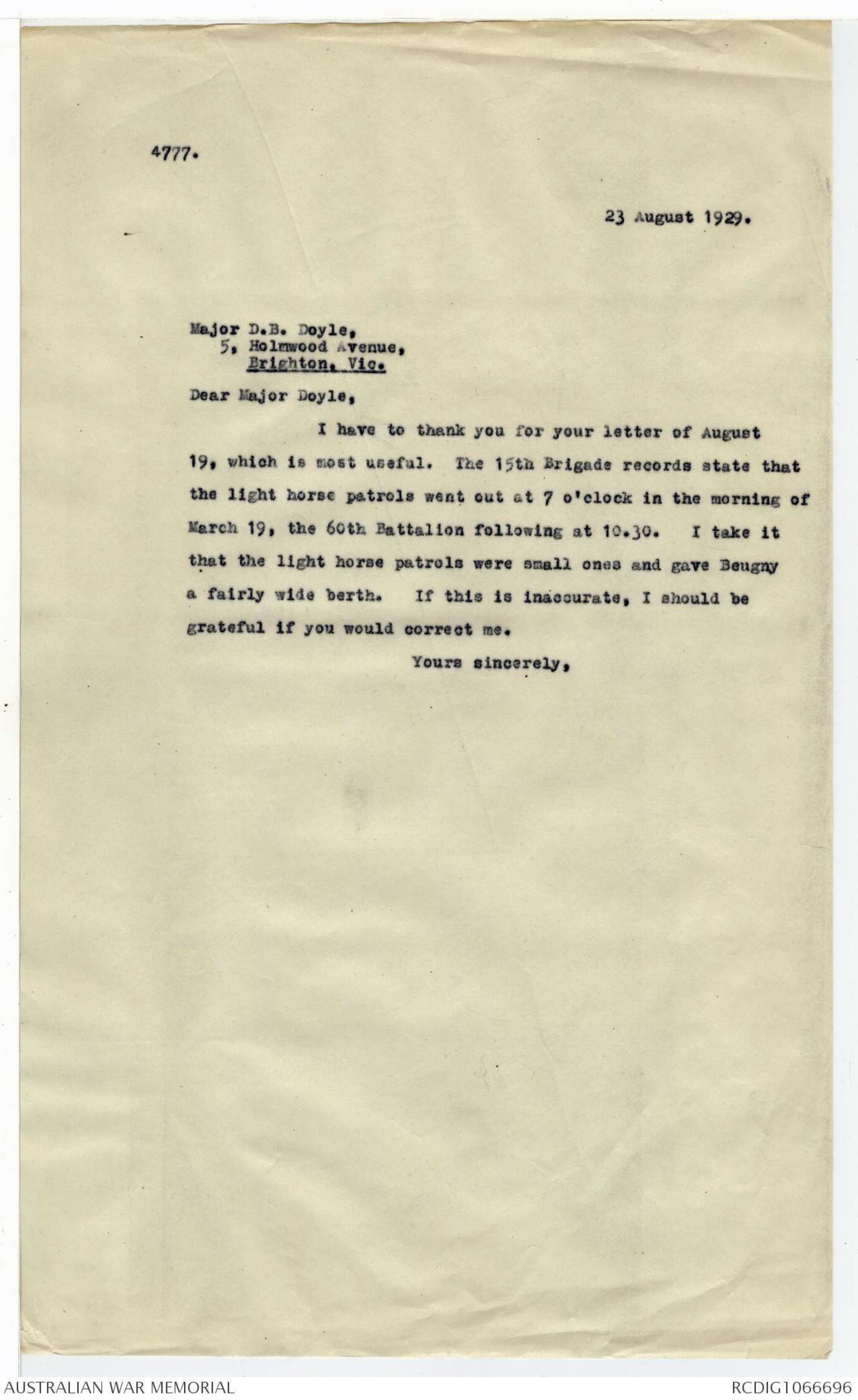
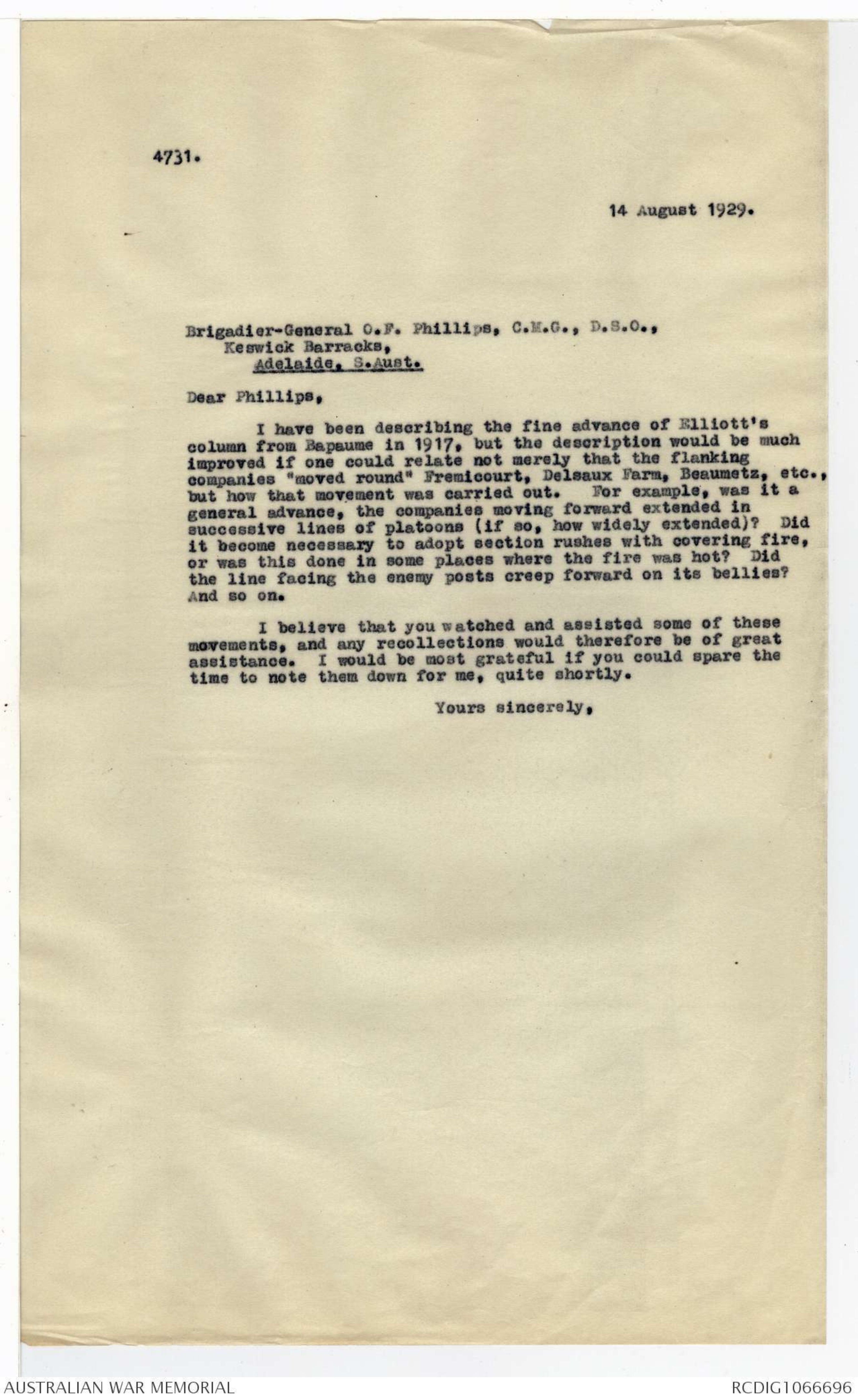
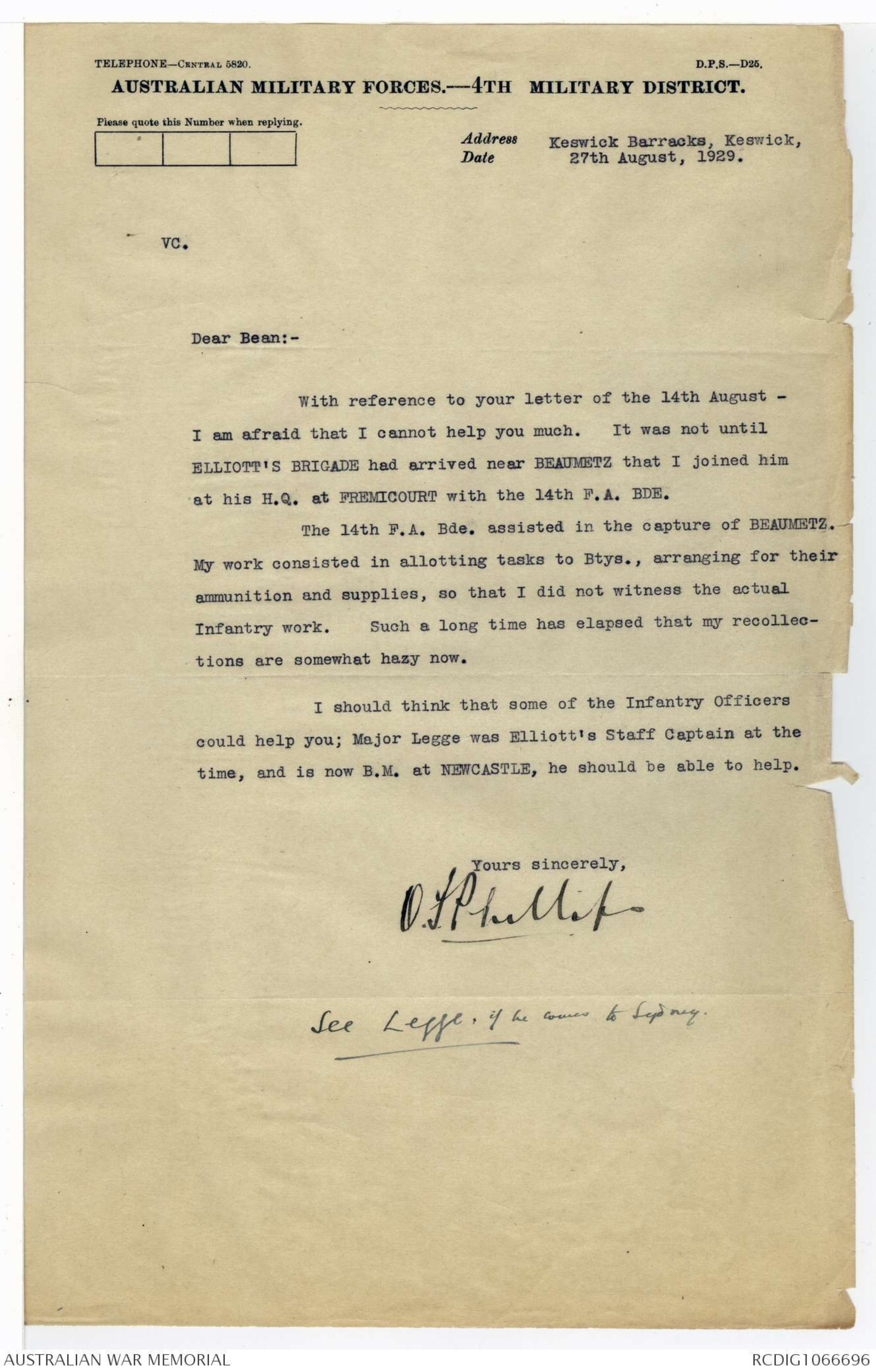
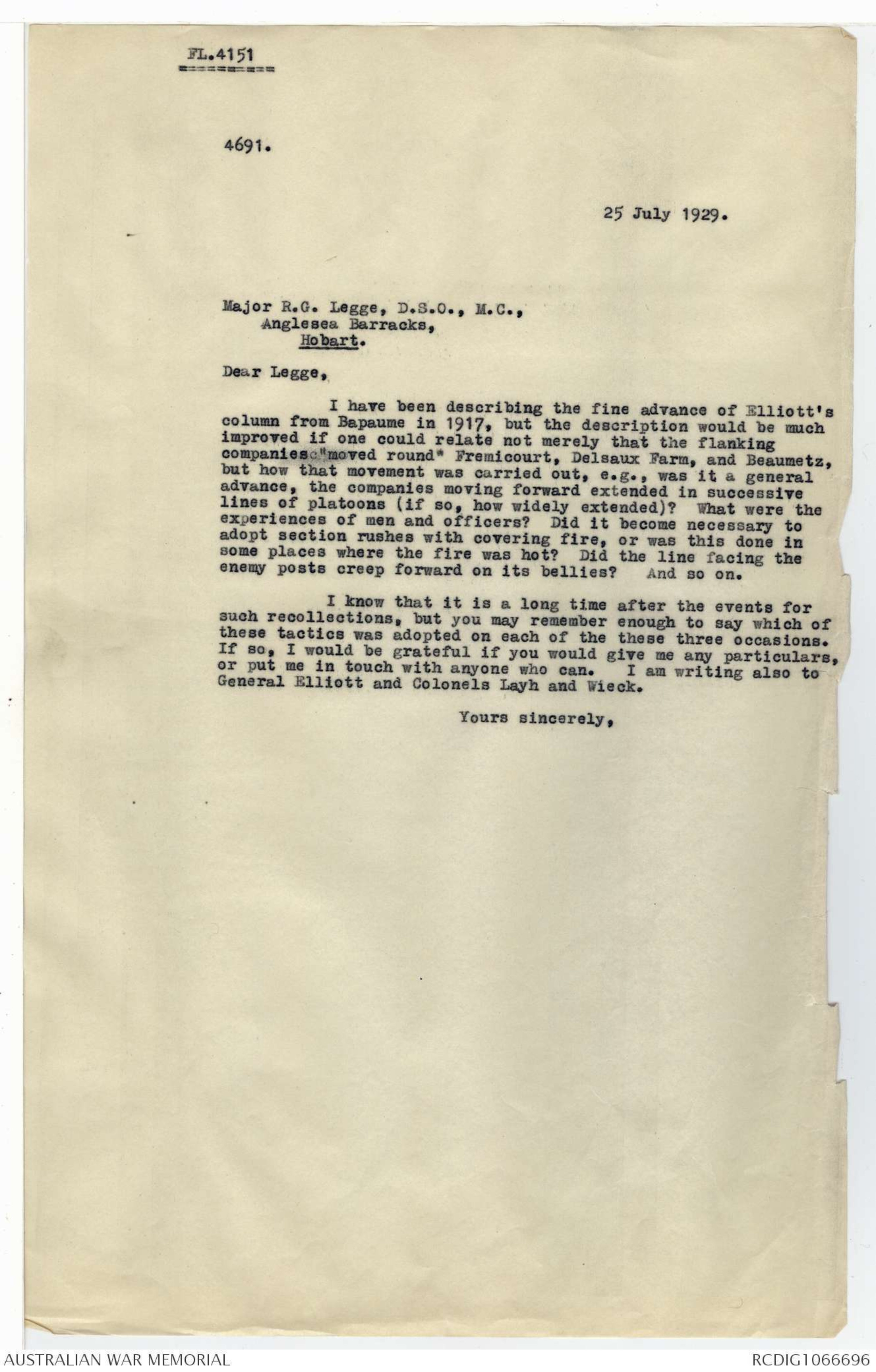
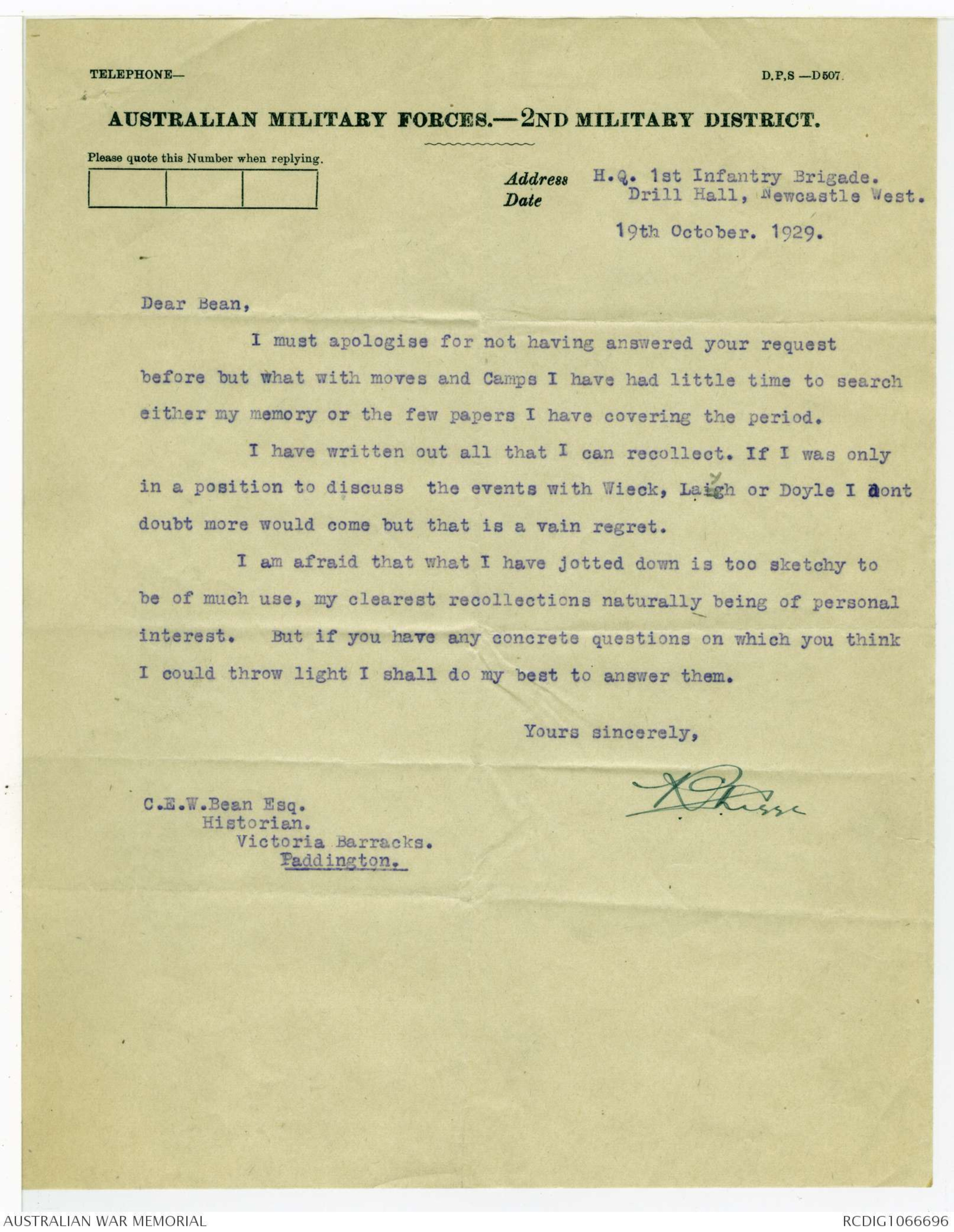
-2-
Beugny fairly solid. Lieut Walker
attacked by 150 Uhlans. Held up
after taking Beugny & dig in on both
sides of road on a line between
Beugny & Morchies. Fearful night.
Wet - dark & stormy. Lieut Knight
gets lost and goes to Morchies."
We were moving as an advance
guard on left side of main road.
Chain of scouts in front - then two
platoons about 500 yards back - in
artillery formation.
Then the main body of 1½ Companies 1 Company
also in Artillery formation. Major
(then Captain) T. Kerr - I think - had
command of a similar body on
the right side of the road.
We were not in touch with any
troops on our left as we had
advanced so rapidly and I had
several small patrols out to guard
our left flank against surprise.
Our instructions were to envelop
villages by going right round them
-3-
- a favourite plan of General Elliott's
afterwards used with great effect in
the recapture of Villers Brettoneux.
We met with no resistance till we
came to V Beugny where our scouts
came under rifle fire - which they returned.
Resistance shortly ceased & our vanguard
passing round the village saw the
Germans retiring along the sunken road
to Morchies.
Lieut Walker who had pushed on
quickly was hampering their withdrawal
& his platoon was attacked by a
troop of Uhlans - estimated at 150 &
apparently detailed as a rearguard.
The appearance of cavalry was a
great novelty but they did not press
the attack & were easily driven off
by rifle fire.
We then established an outpost
line in front of Beugny holding
the line by a chain of platoon
posts with sentry groups some
100 yards in front. Here we
spent the night. It was very wet &
-4-
dark and Lieut Mervyn Knight -
afterwards killed in action - got lost
while visiting his posts - and didn't
return for some hours. He related
on his return that he had entered a
village which he had thought to
be Beugny but which he found to
be in German hands and strongly
held. He had great difficulty in
working his way out through the
German sentry line. He described
a dead horse at the foot of a
crucifix in the centre of the village.
I decided that he must have been
in Morchies & this proved so as
we next day identified the dead
horse and crucifix.
20th March "We took Morchies
and my two companies were
relieved - very tired."
We had a little more resistance
here & were fired at from the village
for some time. We attacked along
both sides of the sunken road
heading from Beugny and the
-5-
enemy evacuated.
This phase of the war was
most pleasant. It was the kind of
operation our troops had been
trained for and for which they
were naturally suited. The relief at
getting away from the trenches and
the mud into the open fields was
generally felt. We also had the
mistaken idea that the enemy was
on the run & that the war was
ending. The only hardship was that
transport difficulties made our rations
late and frequently scanty. Still all
in all the boys were at their best and
were ready for anything.
I've perhaps written over-much
on w what were after all very minor
operations but if you can find a
grain of wheat amongst the chaff you
are more than welcome.
I just recently finished your
last volume which I found most
enthralling. It was most interesting
to learn for the the first time the
-6-
reasons for things that one had
done eleven & twelve years previously.
We of the 5th Division missed Pozieres
and until I read your account of
it I had not realised what the
2nd Division had gone through.
Kind regards
Yours sincerely
D.B. Doyle
4777.
23 August 1929.
Major D.B. Doyle,
5, Holmwood Avenue,
Brighton, Vic.
Dear Major Doyle,
I have to thank you for your letter of August
19, which is most useful. The 15th Brigade records state that
the light horse patrols went out at 7 o'clock in the morning of
March 19, the 60th Battalion following at 10.30. I take it
that the light horse patrols were small ones and gave Beugny
a fairly wide berth. If this is inaccurate, I should be
grateful if you would correct me.
Yours sincerely,
4731.
14 August 1929.
Brigadier-General O.F. Phillips, C.M.G., D.S.O.,
Keswick Barracks,
Adelaide, S.Aust.
Dear Phillips,
I have been describing the fine advance of Elliott's
column from Bapaume in 1917, but the description would be much
improved if one could relate not merely that the flanking
companies "moved round" Fremicourt, Delsaux Farm, Beaumetz, etc.,
but how that movement was carried out. For example, was it a
general advance, the companies moving forward extended in
successive lines of platoons (if so, how widely extended)? Did
it become necessary to adopt section rushes with covering fire,
or was this done in some places where the fire was hot? Did
the line facing the enemy posts creep forward on its bellies?
And so on.
I believe that you watched and assisted some of these
movements, and any recollections would therefore be of great
assistance. I would be most grateful if you could spare the
time to note them down for me, quite shortly.
Yours sincerely,
TELEPHONE-CENTRAL 5820.
D.P.S.-D25.
AUSTRALIAN MILITARY FORCES - 4TH MILITARY DISTRICT.
Please quote this Number when replying.
Address Keswick Barracks, Keswick,
Date 27th August, 1929.
VC.
Dear Bean:-
With reference to your letter of the 14th August -
I am afraid that I cannot help you much. It was not until
ELLIOTT's BRIGADE had arrived near BEAUMETZ that I joined him
at this H.Q. at FREMICOURT with the 14th F.A. BDE.
The 14th F.A. Bde. assisted in the capture of BEAUMETZ.
My work consisted in allotting tasks to Btys., arranging for their
ammunition and supplies, so that I did not witness the actual
Infantry work. Such a long time has elapsed that my recollections
are somewhat hazy now.
I should think that some of the Infantry Officers
could help you; Major Legge was Elliott's Staff Captain at the
time, and is now B.M. at NEWCASTLE, he should be able to help.
Yours sincerely,
O.F. Phillips
FL.4151
4691.
25 July 1929.
Major R.G. Legge, D.S.C., M.C.,
Anglesea Barracks,
Hobart.
Dear Legge,
I have been describing the fine advance of Elliott's
column from Bapaume in 1917, but the description would be much
improved if one could relate not merely that the flanking
companies "moved round" Fremicourt, Delsaux Farm, and Beaumetz,
but how that movement was carried out, e.g., was it a general
advance, the companies moving forward extended in successive
lines of platoons (if so, how widely extended)? What were the
experiences of men and officers? Did it become necessary to
adopt section rushes with covering fire, or was this done in
some places where the fire was hot? Did the line facing the
enemy posts creep forward on its bellies? And so on.
I know that it is a long time after the events for
such recollections, but you may remember enough to say which of
these tactics was adopted on each of the these three occasions.
If so, I would be grateful if you would give me any particulars,
or put me in touch with anyone who can. I am writing also to
General Elliott and Colonels Layh and Wieck.
Yours sincerely,
TELEPHONE-
D.P,S-D507.
AUSTRALIAN MILITARY FORCES.-2ND MILITARY DISTRICT.
Please quote this Number when replying.
Address H.Q. 1st Infantry Brigade.
Drill Hall, Newcastle West.
Date 19th October. 1929.
Dear Bean,
I must apologise for not having answered your request
before but what with moves and Camps I have had little time to search
either my memory or the few papers I have covering the period.
I have written out all that I can recollect. If I was only
in a position to discuss the events with Wieck, Laiyh or Doyle I dont
doubt more would come but that is a vain regret.
I am afraid that what I have jotted down is too sketchy to
be of much use, my clearest recollections naturally being of personal
interest. But if you have any concrete questions on which you think
I could throw light I shall do my best to answer them.
Yours sincerely,
R.G. Legge
C.E.W. Bean Esq.
Historian.
Victoria Barracks.
Paddington.
 Sam scott
Sam scottThis transcription item is now locked to you for editing. To release the lock either Save your changes or Cancel.
This lock will be automatically released after 60 minutes of inactivity.